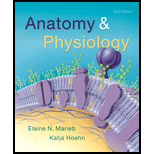
Concept explainers
To determine:
The lobe in which primary motor cortex, Broca’s area, and premotor cortex are located:
frontal
parietal
temporal
occipital
Answer to Problem 1MC
Correct answer:
(a) Frontal: Broca’s area, the primary motor cortex, and the premotor cortex are found in the frontal lobe of the brain.
Explanation for the correct answer:
The brain of an individual consists of four different lobes. The frontal lobe is one among the four lobes and is the largest of all. It is located in the front portion of the brain. The primary motor cortex is responsible for controlling the motor functions and voluntary movements of the body and broca’s area is involved in the production of speech. So option (a) is considered as a correct answer.
Explanation of Solution
Explanation for the incorrect answers:
Option (b) is given as parietal lobe. Whereas primary motor cortex, Broca’s area, and premotor cortex are located in the frontal lobe of the brain. Parietal lobe is characterized by the presence of brodmann area 3, the primary somatosensory cortical area. Thus this option is considered as an incorrect answer.
Option (c) is given as temporal lobe. Whereas primary motor cortex, Broca’s area, and premotor cortex are located in the frontal lobe of the brain. Temporal lobe consists the hippocampus that is critical for long term memory. Thus this option is considered as an incorrect answer.
Option (d) is given as occipital lobe. Whereas primary motor cortex, Broca’s area, and premotor cortex are located in the frontal lobe of the brain. Occipital lobe acts as visual processing center of the brain and consist most of the anatomical region of visual cortex. Thus this option is considered as an incorrect answer.
Hence, option (b), (c) and (d) are considered as incorrect options.
Thus it is concluded that frontal lobe is one among the four lobes of the brain and consists primary motor cortex, Broca’s area, and premotor cortex. The primary motor cortex is responsible for controlling the motor functions and voluntary movements of the body and broca’s area is involved in the production of speech.
Want to see more full solutions like this?
Chapter 12 Solutions
Anatomy & Physiology (6th Edition)
- Amino Acid Coclow TABle 3' Gly Phe Leu (G) (F) (L) 3- Val (V) Arg (R) Ser (S) Ala (A) Lys (K) CAG G Glu Asp (E) (D) Ser (S) CCCAGUCAGUCAGUCAG 0204 C U A G C Asn (N) G 4 A AGU C GU (5) AC C UGA A G5 C CUGACUGACUGACUGAC Thr (T) Met (M) lle £€ (1) U 4 G Tyr Σε (Y) U Cys (C) C A G Trp (W) 3' U C A Leu בוט His Pro (P) ££ (H) Gin (Q) Arg 흐름 (R) (L) Start Stop 8. Transcription and Translation Practice: (Video 10-1 and 10-2) A. Below is the sense strand of a DNA gene. Using the sense strand, create the antisense DNA strand and label the 5' and 3' ends. B. Use the antisense strand that you create in part A as a template to create the mRNA transcript of the gene and label the 5' and 3' ends. C. Translate the mRNA you produced in part B into the polypeptide sequence making sure to follow all the rules of translation. 5'-AGCATGACTAATAGTTGTTGAGCTGTC-3' (sense strand) 4arrow_forwardWhat is the structure and function of Eukaryotic cells, including their organelles? How are Eukaryotic cells different than Prokaryotic cells, in terms of evolution which form of the cell might have came first? How do Eukaryotic cells become malignant (cancerous)?arrow_forwardWhat are the roles of DNA and proteins inside of the cell? What are the building blocks or molecular components of the DNA and proteins? How are proteins produced within the cell? What connection is there between DNA, proteins, and the cell cycle? What is the relationship between DNA, proteins, and Cancer?arrow_forward
- please fill in the empty sports, thank you!arrow_forwardIn one paragraph show how atoms and they're structure are related to the structure of dna and proteins. Talk about what atoms are. what they're made of, why chemical bonding is important to DNA?arrow_forwardWhat are the structure and properties of atoms and chemical bonds (especially how they relate to DNA and proteins).arrow_forward
- The Sentinel Cell: Nature’s Answer to Cancer?arrow_forwardMolecular Biology Question You are working to characterize a novel protein in mice. Analysis shows that high levels of the primary transcript that codes for this protein are found in tissue from the brain, muscle, liver, and pancreas. However, an antibody that recognizes the C-terminal portion of the protein indicates that the protein is present in brain, muscle, and liver, but not in the pancreas. What is the most likely explanation for this result?arrow_forwardMolecular Biology Explain/discuss how “slow stop” and “quick/fast stop” mutants wereused to identify different protein involved in DNA replication in E. coli.arrow_forward
 Principles Of Radiographic Imaging: An Art And A ...Health & NutritionISBN:9781337711067Author:Richard R. Carlton, Arlene M. Adler, Vesna BalacPublisher:Cengage LearningSurgical Tech For Surgical Tech Pos CareHealth & NutritionISBN:9781337648868Author:AssociationPublisher:Cengage
Principles Of Radiographic Imaging: An Art And A ...Health & NutritionISBN:9781337711067Author:Richard R. Carlton, Arlene M. Adler, Vesna BalacPublisher:Cengage LearningSurgical Tech For Surgical Tech Pos CareHealth & NutritionISBN:9781337648868Author:AssociationPublisher:Cengage Human Physiology: From Cells to Systems (MindTap ...BiologyISBN:9781285866932Author:Lauralee SherwoodPublisher:Cengage Learning
Human Physiology: From Cells to Systems (MindTap ...BiologyISBN:9781285866932Author:Lauralee SherwoodPublisher:Cengage Learning





